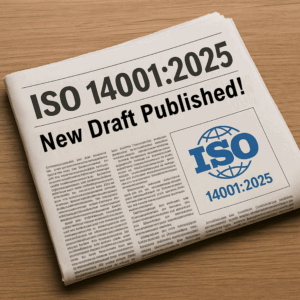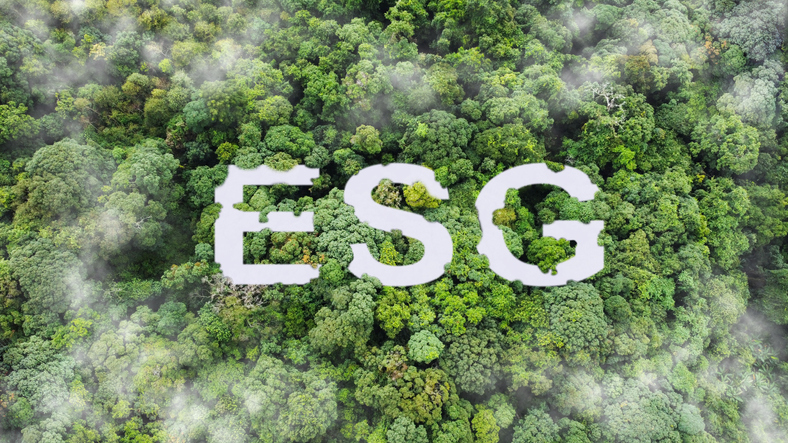
News
Draft of the New Version of ISO 14001 Published
02.07.2025
The long-anticipated draft of the international standard ISO 14001 for environmental management systems has recently been released in the form of ISO DIS 14001:2025. The final standard is expected to be published in January 2026, marking the official start of the transition period for certified organizations. In the meantime, the so-called Final Draft (FDIS) will be issued, expected in October 2025.
Although the DIS version of ISO 14001 is now subject to a 12-week voting period, it is already clear what the final 2026 edition will look like and where certified organizations should focus their preparations.
Key Areas of Change:
The objective of the revision is to update ISO 14001 so that it remains relevant in the face of today’s environmental challenges — climate protection, biodiversity loss, resource scarcity, and growing stakeholder attention — while also aligning it more closely with other ISO management system standards. For most organizations, this means refining their existing EMS processes rather than reinventing them.
Specifically, the following changes and additions to the requirements are currently included:
- Environmental Aspects
Greater emphasis on environmental aspects such as climate change, biodiversity, and resource availability. - Scope of the EMS
Decisions regarding the scope must now be made from a life cycle perspective to ensure that upstream and downstream impacts, which the organization can control or influence, are not overlooked. - Interested Parties
Stronger alignment with ISO 9001, making it easier to identify whose expectations are relevant. - Leadership
Increased personal commitment from top management. - Risk-Based Approach
Risks and opportunities are now more closely linked to environmental aspects, compliance obligations, and planned actions. - Change Management
Greater emphasis on the need for organizations to systematically plan and manage EMS-related changes. - Guidance on Life Cycle and Emergency Preparedness
New guidance on how to apply the life cycle perspective and a requirement to identify potential emergency situations separately from normal environmental aspects. - Suppliers and Subcontractors
Strengthened focus on the need to control or influence externally provided processes, products, or services, with the degree of control now required to be documented.
Recommendations for Certified Organizations:
- The transition period for adapting to the new standard will likely be 3 years, providing ample time for system revisions.
- Organizations seeking to take early action and demonstrate leadership to stakeholders can already begin with the following changes, which are unlikely to be revised further:
- Review your life cycle perspective and EMS scope to ensure upstream and downstream impacts are adequately addressed.
- Introduce or formalize controls for change management in line with the new Section 6.3.
-
Demonstrate leadership accountability by updating role descriptions, policies, and communication materials.

CSRD innovations through omnibus procedures
03.04.2025
On February 26, 2025, the EU Commission proposed a simplification of CSRD sustainability reporting with the so-called Omnibus Package, with the following key points:
- Reporting obligation only for companies with more than 1,000 employees and a turnover of more than €50 million or a balance sheet total of more than €25 million;
- Delaying the initial reporting obligation for companies in the “second and third waves” by two years each;
- Publishing the VSME standard for voluntary reporting for small and medium-sized enterprises developed by EFRAG as a delegated act;
- Restricting the collection of information from SMEs in the value chain to the information specified by the VSME standard;
- Simplifying the ESRS standards to reduce the number of required data points;
- Avoiding the introduction of sector-specific reporting standards;
- Sustainability report audit only with limited assurance
As of April 3th 2025, the EU Parliament has already decided to postpone the initial reporting obligation for companies in the “second and third waves” by two years each, meaning that legal uncertainty for companies no longer exists.
From the current perspective, it is expected that the remaining proposed amendments will also be adopted as proposed.
For companies with fewer than 1,000 employees, voluntary sustainability reporting on supply chains in accordance with the VSME standard is expected to become established in the future.
These sustainability reports can then also be subject to external auditing on a voluntary basis, although this does not currently require auditors to do so.
Interview with ESG expert Hans Kitzweger
18.09.2024
ESG expert Dipl.-Ing. Hans Kitzweger, MBA in an interview at the UAS Technikum Wien on the topic of “ESG”. Among other things, he provides information on the background to the ESG trend and why more or less all companies will soon have to consider and optimize their ESG performance. Hans Kitzweger gives a lecture on greenhouse gas accounting as part of the ESG manager training program at the UAS Technikum Wien.
Click here for the interview on LinkedIn.
Click here for the full version (10 minutes) of the interview
Climate change included in ISO standards
27.03.2024
Having committed itself to combating climate change with the London Declaration, ISO has now published an addition to many of its existing standards for management systems with 23.2.2024. Specifically, the relevance of climate change risks was added to the analysis of the organizational context and the requirements and expectations of interested parties in the standards. With the new additions, every certified organization must include climate change in its context analysis and if it considers it relevant, it must be taken into account in the design and implementation of the management system. The addition to climate change affects all certifiable ISO standards for management systems, e.g. ISO 9001, ISO 14001, ISO 45001, ISO 50001, ISO 15378, ISO 19443, ISO 21001, ISO 22000, ISO 22301, ISO 28000, ISO 29001, ISO 37001, ISO/IEC 20000 and ISO/IEC 27001 etc. To date, 31 standards have already been added and more are to follow successively.
Specifically, the changes in chapter 4 of the standards were incorporated as follows:
- 4.1 Understanding the organization and its context: New requirement: “The organization must determine whether climate change is a relevant issue.”
- 4.2 Understand the needs and expectations of interested parties: New requirement: “NOTE: Relevant interested parties may have requirements in relation to climate change.”
Specifically, the new requirement states that organizations must determine whether climate change is a relevant issue and whether relevant interested parties have requirements related to climate change. If this is the case, climate change must be taken into account when designing and implementing the management system. In the case of ISO 9001 certification, for example, this can be aimed at determining whether the organization has identified all contractually agreed customer requirements or legal and regulatory requirements relevant to climate change that are applicable to its products and services. All certification bodies must take these new requirements into account with immediate effect, i.e. without a transitional period, in their next audits. Non-compliance with the new requirements can also lead to deviations. Companies that are already certified must therefore deal with the new requirement immediately. Together with ISO, the IAF (International Accreditation Forum) issued the “Guidance on: Auditing Climate Change issues in ISO 9001“. Existing certificates do not have to be reissued, as the revisions of the standards have not changed. Questions? Let us advise you on this topic.

New ISO 14068-1 for the certification of climate neutrality
11.03.2024
Following increasing greenwashing in the economy with regard to statements on climate neutrality, the International Organization for Standardization (ISO) has taken up this issue and published the new ISO 14068-1 standard at the end of 2023. According to this standard, it is now possible for the first time to have the climate neutrality of an organization or a product certified (or verified) according to an internationally recognized standard.
Contents and requirements of ISO 14068-1
The title of the standard “Climate change management – Transition to net zero” already indicates that it is not just a “calculation approach”, but that certain management system requirements are also included. For example, top management is required to commit to climate neutrality or a PDCA improvement cycle. The standard can be applied to a wide variety of subjects, such as organizations, products, services, projects or events. Regardless of which units the standard is applied to, the following steps must be implemented:
- Commitment to climate neutrality
- Definition of the scope of application
- Determination of GHG emissions and removals
- Management plan for climate neutrality
- Minimizing the CO2 footprint
- Report on climate neutrality
- Statements on climate neutrality
The management plan for climate neutrality is a key element. This describes, among other things, the structural and procedural organization, the short and long-term goals, the time frame, the GHG reduction measures, the financial and human resources, the indicators for monitoring progress and the quantity and type of certificates used for offsetting. The latter shows that the standard also allows greenhouse gases to be offset by means of certificates. However, strict criteria are defined for such compensation. The publicly accessible report on climate neutrality creates transparency for stakeholders. The requirements regarding “statements on climate neutrality” stipulate that such statements may only be made if the requirements of the standard are met and the accuracy and integrity of the information have been verified. The reference to the ISO 14064-1 and ISO 14067 standards is that these are to be used as the basis for calculating the GHG footprint.
Conclusion
ISO 14068-1 thus clarifies the previously very different and sometimes misleading communication on the subject of climate neutrality. With certification, organizations can credibly demonstrate their actual activities in terms of climate neutrality and thus create trust with stakeholders. For companies that are already active in the field of climate neutrality, it is a relatively small step to introduce a climate management system based on the management plan required by the standard.

EU regulation on climate neutrality plans for EU ETS installations entered into force
20.12.2023
Under the European Climate Law (Directive 2003/87/EC), certain operators of installations subject to the European Emissions Trading System (EU ETS) must draw up climate neutrality plans to avoid a 20% reduction in the free allocation of CO2 allowances from 2026. Specifically, this affects installations with installation parts for which a product reference value applies and whose individual emission factor is below 20% of the highest values of the existing reference values (product benchmark) for the sector in question. The climate neutrality plans must be drawn up and submitted to the authority by May 1, 2024. Prior to this, the climate neutrality plans must be reviewed by an accredited verification body as part of the baseline verification for the next allocation period. On October 31, 2023, the content and format of the climate neutrality plans required for the free allocation of emission allowances were regulated by the EU in Commission Implementing Regulation (EU) 2023/2441 of October 31, 2023 laying down detailed rules for the implementation of Directive 2003/87/EC of the European Parliament and of the Council as regards the content and format of the climate neutrality plans required for the free allocation of emission allowances (europa.eu)) to Directive 2003/87/EC. The climate neutrality plans must therefore include the following, among other things:
- Historical emissions of the system
- Milestones and emission reduction targets in five-year periods from 2025
- Action plans and cost breakdown in five-year periods from 2025
- Detailed explanation of the planned measures to achieve the milestones and emission reduction targets for each five-year period
- Costs of the measures and investment amount for each calendar year
The Implementing Regulation 2023/2441 does not contain the threshold values that exceed 80% of the emission values. This must be determined by the companies concerned themselves in order to find out whether a climate neutrality plan needs to be drawn up. The regulation governing free allocation (EU Allocation Regulation), which is currently being revised and is due to come into force in the first quarter of 2024, could provide further details. risksafe ESG has many years of experience with EU emissions trading and will be happy to support you in drawing up a climate neutrality plan.

Agreement on EU supply chain law
15.12.2023
Yesterday, the EU Parliament agreed on the so-called “EU Supply Chain Law” (Corporate Sustainability Due Diligence Directive, CSDDD) in the trilogue negotiations. The new EU directive will mean that large companies with more than 500 employees (or 250 employees in high-risk sectors) will also have to ensure that their suppliers and their business partners abroad comply with environmental and social standards in future. Following national implementation of the directive, the obligations will apply from the beginning of 2026. The new regulation is an important step towards preventing exploitation worldwide and creating fair and humane working conditions. You can find out how best to implement the new requirements here.

“ESG jungle” explained simply
1.12.2023
Based on the corresponding legal regulations in the EU, ESG (Environmental, Social, Governance) has established itself as a buzzword for sustainable management. According to EU regulations, companies must report on their ESG performance in future and also have this audited externally. On the other hand, banks and other providers of financial products will have to take the ESG performance of companies into account, making it more difficult for non-sustainable companies to obtain financing. As companies must also pay attention to sustainability in their supply chain, sooner or later all companies will de facto have to act sustainably in order to remain successful.

